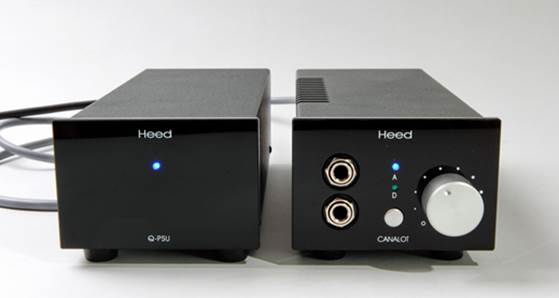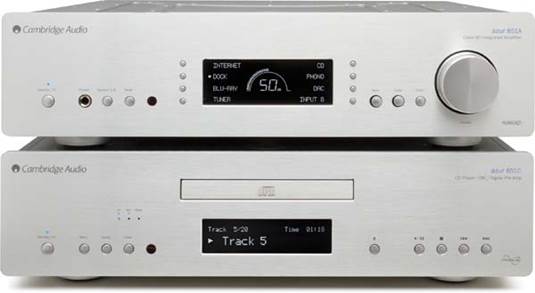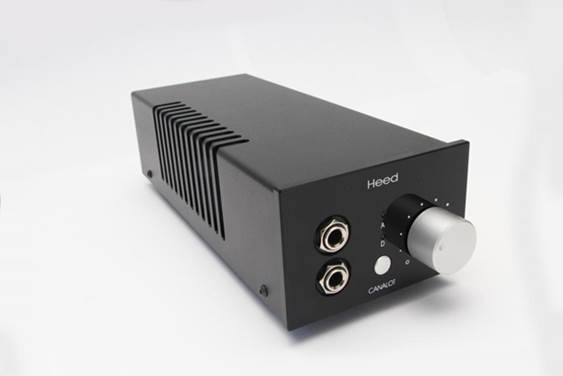Heed Audio’s new Canalot is either a
nod to the future or a one-off oddity – We take a look at the DAC that does
things differently
Not content with bouncing back from
extinction, DAC’s have been assuming the functions of other products of late.
First, they started sprouting headphone sockets, and thus a volume control.
Then the volume control began to control the line output as well as the
headphone socket, creating a digital preamp. Now, Heed Audio has launched a
product that approaches this from the other direction. The Canalot headphone
amplifier can now be specified with a DAC board creating a small, but
impressively multifunctional device. This is the full-spec version with USB and
is yours for $1,875. A cheaper model with only the analogue input is also
available.
Due to the limited number of inputs, the
Heed is multifunctional but also rather minimalist. You have a choice of coaxial
and USB digital inputs but as these select by detecting voltage, you cannot
have both at the same time. You also have a single analogue input. Unless you
start adding boxes with input switching elsewhere, the Heed is effectively a
two input device. This need not be the end of the world – I generally only have
one digital and one analogue source but there are models available at similar
price points that offer more connection options.

Head
Audio Canalot DAC Headphone Amp/Preamp: Space oddity
One area where the Canalot is well
specified is in headphone outputs. The front panel features a pair of ¼in jack
connections rather than just the one, which presumably allows audiophiles to
involve their partner in some silent mutual appreciation. Quite how often this
happens is open to debate but it might make somebody happy. The jacks both
share the same volume control, so if you are going to use them at the same time
headphones of similar sensitivity are advised.
The build of the Canalot is a slightly
mixed bag. The ‘Modular’ range of components that the Canalot belongs to don’t
feel as solid as the more expensive Obelisk models, which are rather nice.
Input selection is by a single button that moves between analogue and digital
(digital selection as previously mentioned is automatic). The casework of the
main unit and matching power supply feels reasonably substantial, but nothing
to get excited about. This is further undermined by the volume control that has
a fairly significant amount of slack in it and some curious clicking noises
that the unit makes when USB is selected. The overall effect is tidy enough,
but there are certainly better finished devices out there for the price.
The volume control – slack aside – is a
conventional pot rather than a digital encoder so it feels normal enough in use
and doesn’t have any of the unwelcome side effects that bit reduction can have.
The USB input is also a 24-bit/192kHz-capable asynchronous type, controlled by
a driver downloaded off the Heed website, so for computer audio fans the
Canalot could be an interesting interface to a pair of active speakers or
similar. Installation proved to be hassle-free and didn’t result in any
gremlins cropping up on the computers it was installed on.
Sound quality
As such, I started using the Canalot as an
interface between a Lenovo ThinkPad running Songbird and a Cambridge Audio 851A
used first as an integrated and them a power amplifier. This in turn powered a
pair of Neat Momentum 4i loudspeakers. The first impression the Heed provides
is a rather unusual one. The performance improves noticeably in the first 30
minutes or so after turning the Canalot on. Initially the performance is a
little flat and lifeless, but it livens up considerably in the opening
listening period.

Cambridge
Audio 851A
Many of the attributes of the Canalot are
similar to the Dactilus 3 that appeared in a recent group test. The
presentation has a pleasing sense of life and vitality to it, but at the same
time avoids sounding overblown or forced. With the lovely high resolution FLAC
of Mark Knopfler’s Privateering, the Heed manages to reproduce the detail and
depth of the recording without losing sight of the musicality of the whole
piece. The timing is good too and it manages to sound controlled and cohesive
without forcing slower, more relaxed material.

It
manages to sound controlled and cohesive without forcing slower, more relaxed
material
Detail retrieval is good, too. The Canalot
manages to find information in the bass especially that is deeply impressive. The
bass response as a whole is deep and controlled and this helps give the Heed a
sense of energy that is very welcome. Like the Dactilus 3, the Canalot has a
slightly limited soundstage. The positioning of instruments and musicians
between the speakers is convincing enough but the soundstage doesn’t extend
much beyond them. This gives smaller pieces a sense of intimacy, although
larger works can sound a little restrained.
Putting the Canalot’s volume control into
the circuit doesn’t significantly change the performance. The volume control is
linear enough and gives perfectly satisfactory control over volume levels. The
analogue input is impressively transparent in use and it is hard to determine
between a Naim ND5XS running through the Canalot and connected directly to the
851A. Most of the sonic character that the Canalot possesses seems to be
present in the digital inputs and used via the tape loops of the 851A, the Heed
puts very little of itself into the presentation.